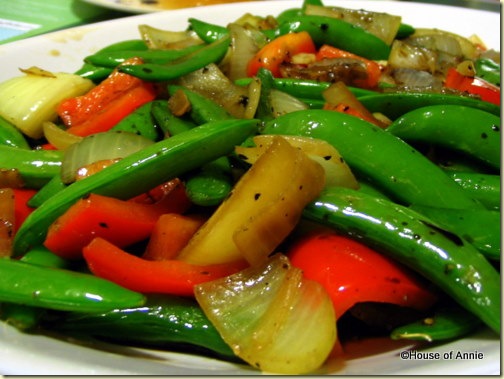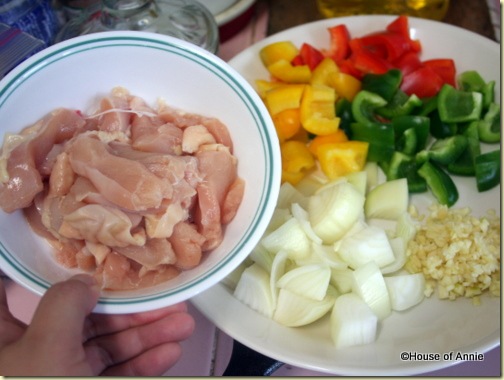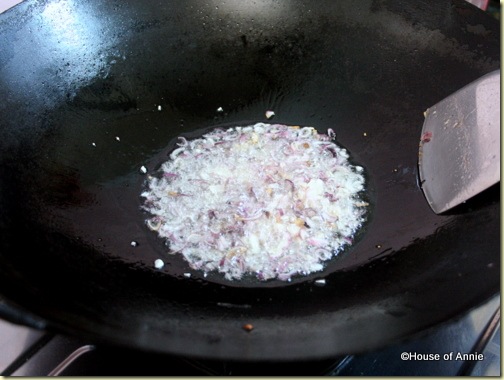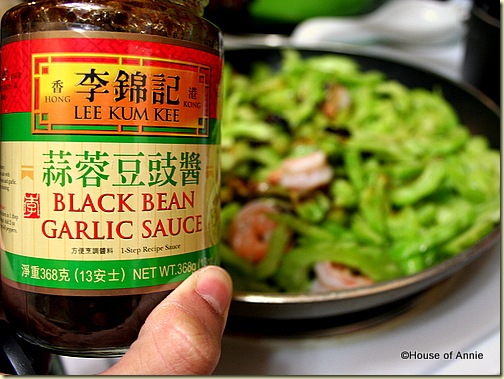We aren’t always about eating meat.
Stir-Fried Green Beans with Savory Tofu
Really, truly! I know that it must seem that way with the many recipes that I post that are always about meat—we have lots of chicken recipes, pork recipes, beef recipes, and not as many vegetable recipes.
The reason for this is simple. Stir fried vegetables seem boring and easy. Surely, most people know how to stir fry some vegetables and don’t need recipes for it?
Right?
Turns out that sometimes, what I take for granted isn’t as instinctive for others. For me, salad isn’t that instinctive. I like eating salads but I don’t think of it as a vegetable dish to make with my meals. For many of you, salad is probably something you find a no-brainer. Well, that’s how it is for me with vegetable stirfries.
Anyway, I decided to let you know readers that we do eat loads of veggies. As a matter of fact, every meal that I make is accompanied by a vegetable side, sometimes two. And they are mostly stirfries. Why? Because it’s fast and easy.
Here are my basic rules for stir-frying:
1. Oils
You do need a little oil when you stir-fry. I tend to use about 2 Tbsp of oil to most of my stir-fries. It’s not too much when you consider how much goes into salad dressing.
As for the type of oils, I tend to like neutral high smoking point oils like canola, or peanut oils. I sometimes add a little sesame oil to the mix but you have to watch when you use sesame oil as it burns more quickly. You can also use light olive oil but I don’t recommend extra virgin olive oil. Save that for your salad instead.
2. Aromatics
You need garlic and sometimes shallots or other onions. But you always need garlic. Don’t even think about skipping garlic. It’s the main component of any stir fry. Whether you mince it, slice it, leave it whole, it’s gotta be there.
For me, on the weekend, I take out about 2 heads of garlic and just peel and mince the whole lot and stick it into a small container and leave it in the fridge. That way, come the weekday when I am stir frying my vegetables, I just need to grab that container, grab a spoonful and add to my stir fry.
Frying Garlic and Shallots
3. High heat
A gas burner and a wok is useful but if you have an electric stove, a large frying pan may work better. Now that I have a gas stove, and a wonderful wok, I find that my veggies will get nicely stir fried without having to resort to closing the lid and steam-frying it.
Steam-frying is the alternative if you cannot get your fire hot enough—cover your pan with a lid and let the veggies cook through that way. It won’t be as good as a “real” stir-fry but it’ll work.
4. Creative Seasoning
A stir fry can be seasoned as simply as with salt and pepper but we Asians have created numerous sauces and spices that can be added to change up your vegetable stir-fries. Some seasonings I like to use with my stir-fries include oyster sauce, hoisin sauce, black bean sauce, brown bean sauce, fish sauce, soy sauce, XO sauce, sambals, belacan, and other spices like ginger, mustard seeds, turmeric, chillies.
Ok, that’s a long list but you can imagine the possibilities! Just don’t add them all in at once. ^_^
Black Bean Sauce
5. Color
Vegetables should be vibrant and in a stir-fry, it’s nice to have two types of vegetables in contrasting colors to make the dish look more appetizing and colorful. After all, we also eat with our eyes! Many times, I will add some sliced carrots on top of whatever green veggie I have to give color contrast. Other times, slices of red bell pepper (or red chilli pepper) will also make your dish pop. That said, there’s nothing wrong with a stir-fry of just spinach or some other dark green leafy vegetable. When done right, green vegetables are vibrant when cooked. Just don’t cook them till they turn puke yellow—that is not an attractive color.
Stir-Fried Peas, Peppers and Onions

6. Protein optional
When I was growing up, my mom always added some protein to her vegetable stir-fries so that was all I knew. She would add some shrimp, or sliced pork/chicken along with the vegetables. When I got to Hawaii, a friend remarked that I seemed unable to make anything truly vegetarian. I had to think on that and he was right.
These days, I don’t use much protein in my stir-fries anymore unless I want to combine dishes and do a two-in-one. Some veggie dishes do work with some protein like the Stir-Fried Pork with Long Beans dish I recently blogged about. Also, tofu is a great protein to add to other vegetable dishes (though firm tofu is better in a stir-fry). So it’s up to you whether you want to add any protein.
7. Order in cooking
Always make sure you have prepped everything ahead of time as stir-fries are FAST!
Prepped Ingredients for Black Bean Chicken
 You can’t be chopping or cutting vegetables when you’ve already put something in. Remember stir-fries are done in high heat! So here’s my order when it comes to stir-fries:
You can’t be chopping or cutting vegetables when you’ve already put something in. Remember stir-fries are done in high heat! So here’s my order when it comes to stir-fries:
a. Start with a hot wok. The wok should be really hot before anything goes in. Then add a little oil.
b. Next comes the aromatics. Throw in the garlic and whatever other aromatics (ginger, onions, shallots, spices like mustard seeds or cumin). Let that brown a little but be careful not to burn it. Garlic burns very quickly so you have to be ready with the next ingredient. Keeping your spatula dancing in the wok also helps it not to burn.
c. If adding protein, add now. The only exception is tofu. Since tofu is more fragile, you want to add that closer to the end.
d. Add vegetables. Start with the ones that take a longer time to cook through (for example, I would add carrots first and let that stir-fry for a good 2-3 minutes before adding leafy vegetables). Also think about whether you want the vegetable to stay somewhat crunchy or be more wilted. Depending on the level of doneness you want is how you should consider the timing.
e. Season. Now is the time to season unless your dish calls for sambal (sambals normally need to be added in the beginning with the garlic so treat them like an aromatic). I normally will add my sauces at this time. You can also keep it simple by just using salt. And always finish with some pepper. For stir-fries, I prefer white pepper though black pepper will also work.
f. Garnish at the end. There is nothing better than fried shallots or fried garlic to hit the vegetables with at the end. But this is only if you want to get fancy. You can also garnish with cilantro or green onions for additional flavor and color.
Stir-Fried Green Beans with Fried Shallots
Phew! What a long post for something so simple. Crazy huh? And I have not even given you a recipe, just building blocks to go crazy on your own. I will try to post a few of my vegetable stir-fries to give you some ideas if you really are clueless about doing them.
Do you have a simply delicious stir-fry combination? Share it with us in the comments!
Cheers, Annie
Other stir-fry recipes from around the blogosphere:
Recipe for Spicy Stir-Fried Sugar Snap Peas with Soy Sauce, Sesame Oil, and Sriracha on Kalyn’s Kitchen
Cantonese Tomato Beef on Appetite for China
Black Pepper Scallion Beef on Nasi Lemak Lover
Stir-fry Leeks with Vegetables on NoobCook
Shrimp and Celery with Ketchup Tobanjian Sauce on Just One Cookbook




I demand that you get gochujang!!! Really nice for stir-fries. I also love using miso and kecap manis. Not necessarily together. The best aromatics to me is garlic (a MUST, as you said), shallots and ginger. That’s the most lovely fragrance ever and I love to hear that sizzle of the oil.
Sophia,
I love kochujang, but we don’t use it enough to keep a big tub of it in the fridge.
So you use miso as a stir-fry flavoring? What’s your favorite stir-fry recipe using miso?
I stir fry all the time, but I’m lazy and untraditional, and put meat (or tofu) and a mixture of vegetables all together in the wok. Too lazy to make separate side dishes all the time.
Here’s a recipe that has been popular with my readers and guests for a while–Honeyed Chicken with Snap Peas and Carrots
http://www.tigersandstrawberries.com/2011/05/27/honeyed-chicken-with-snap-peas-and-carrots/
Great tips. My mom always said that adding a pinch of salt to the green vegetables right after they go into the wok will make them pop bright green. Not sure if that’s why they go brightly green, but it seems to work!
Excellent! I love stir fry and now you’ve inspired me to make it more often!
love the tips, esp the part about colour and order of cooking 🙂
Here’s a quick and easy way to do a veggie stir fry without actually frying or using a lot of oil. I do it all the time.
Put 1/2 tsp chopped garlic and/or onion or ginger and 1/2 Tbs oil in
hot stock (chicken stock or ikan bilis stock or Japanese dashi) and
add chopped leafy vegetables (like mustard green, napa cabbage
or kai lan, etc) when it comes to a boil. Stir slightly, add salt and pepper and drizzle in a bit of sesame oil after 2-3 minutes. Dish is done!
Stir-fry. Oh the aroma of garlic, shallot or onion, and ginger. I don’t care if people smell the garlic when I speak.
Well, I stir-fry all the time. I stir-fry everything. I think it’s what makes Asian food stand out from the rest of the world.
Love the crispy shallots on the beans. Just want to pick them off with my fingers and pop them into my mouth.
I love stir-frying, too. It works well with most any veggies. And all the time is really in the prep. The cooking itself is over in a flash, and then dinner’s on the table just like that.
This is a great post with helpful tips. I really enjoyed learning about stir-frying. I do use a lot of stir frying method for my meal, but mostly Japanese (and little bit of Chinese). I love the black bean garlic sauce. YUM!
I eat stir frys about 5 days per week. I love them because they are great for low carb meals and they are also low in fat.